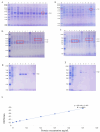Preparation and immunogenicity studies of NvIBDV VP2-ferritin nanoparticles
- PMID: 40764574
- PMCID: PMC12326652
- DOI: 10.1186/s12917-025-04914-6
Preparation and immunogenicity studies of NvIBDV VP2-ferritin nanoparticles
Abstract
Background: Infectious bursal disease (IBD), caused by infectious bursal disease virus (IBDV), is a highly contagious disease that is prevalent worldwide and poses a significant threat to the poultry industry. While commercially available vaccines are used for prevention, IBD outbreaks remain frequent.
Objective: The continuous mutation of virulent strains and their ability to evade traditional vaccine protection complicate IBD control, which necessitates the development of novel vaccines and a deeper understanding of viral mutation mechanisms.
Method: Utilizing the self-assembly capability of ferritin (Fe), the hypervariable region (HVR) protein of a novel variant IBDV (NvIBDV) VP2 was displayed on the ferritin shell, forming regular nanoparticles. The full-length NvIBDV VP2 protein and the NvIBDV VP2-HVR-Fe fusion protein were prokaryotically expressed in E. coli and purified to prepare a VP2 protein vaccine and a VP2-Fe nanoparticle vaccine. An inactivated NvIBDV vaccine served as a control for evaluating immunogenicity and protection.
Results: Recombinant prokaryotic expression vectors pET-VP2-Fe (encoding VP2-HVR-Fe) and pET-VP2 (encoding full-length VP2) were successfully constructed. Soluble VP2-Fe and VP2 proteins were expressed and purified. Electron microscopy confirmed the formation of a cage-like nanoparticle structure for VP2-Fe. Immunization of SPF chickens with NvIBDV VP2-Fe nanoparticles induced a robust immune response characterized by high antibody titers and a significantly high protection rate against viral challenge.
Conclusion: The successfully constructed recombinant subunit nanoparticle vaccine, which displays the NvIBDV VP2 HVR on ferritin, effectively increased the antibody titer and provided superior immune protection. This approach offers a feasible strategy for developing novel IBDV subunit vaccines.
Keywords: Ferritin; Infectious bursal disease virus; Nanoparticles; Novel mutant strain; Subunit vaccine.
© 2025. The Author(s).
Conflict of interest statement
Declarations. Ethics approval and consent to participate: All animal experiments were performed in accordance with the Guidelines for Care and Use of Laboratory Animals of Shanxi Agricultural University, China, and the animal study was reviewed and approved by the Animal Ethical Committee of Shanxi Agricultural University, China. Approval No. SXAU-EAW-2024 C.NR.012026285. Consent for publication: Not applicable. Competing interests: The authors declare no competing interests.
Figures






Similar articles
-
Development of a recombinant VP2 vaccine for the prevention of novel variant strains of infectious bursal disease virus.Avian Pathol. 2020 Dec;49(6):557-571. doi: 10.1080/03079457.2020.1791314. Epub 2020 Sep 8. Avian Pathol. 2020. PMID: 32658552
-
Development and Application of Indirect ELISA for IBDV VP2 Antibodies Detection in Poultry.Viruses. 2025 Jun 20;17(7):871. doi: 10.3390/v17070871. Viruses. 2025. PMID: 40733489 Free PMC article.
-
Chicken IL-17 as a potent adjuvant enhances IBDV VP2 DNA vaccine immunogenicity and protective efficacy.Poult Sci. 2025 Aug;104(8):105247. doi: 10.1016/j.psj.2025.105247. Epub 2025 May 1. Poult Sci. 2025. PMID: 40347786 Free PMC article.
-
The History of Infectious Bursal Disease: The Second Period Between 1977 and 2005.Avian Dis. 2025 Jun;69(2):134-145. doi: 10.1637/aviandiseases-D-24-00095. Avian Dis. 2025. PMID: 40643932 Review.
-
Dynamic alterations in T-lymphocyte subsets assessed by flow cytometry in chickens following exposure to infectious bursal disease virus: A systematic review.Dev Comp Immunol. 2025 Jan;162:105280. doi: 10.1016/j.dci.2024.105280. Epub 2024 Oct 11. Dev Comp Immunol. 2025. PMID: 39396690
References
-
- Liao Jiedan C, Yuming Z. Research progress on molecular pathogenesis of infectious bursal disease virus [in chinese]. China Poult. 2018;40(05):1–5.
-
- Fan L, Wu T, Wang Y, et al. Novel variants of infectious bursal disease virus can severely damage the bursa of Fabricius of immunized chickens. Vet Microbiol. 2020;240:108507. 10.1016/j.vetmic.2019.108507. - PubMed
-
- Myint O, Suwanruengsri M, Araki K, et al. Bursa atrophy at 28 days old caused by variant infectious bursal disease virus has a negative economic impact on broiler farms in Japan. Avian Pathol. 2021;50(1):6–17. 10.1080/03079457.2020.1822989. - PubMed
-
- Xu A, Pei Y, Zhang K, et al. Phylogenetic analyses and pathogenicity of a variant infectious bursal disease virus strain isolated in China. Virus Res. 2020;276:197833. 10.1016/j.virusres.2019.197833. - PubMed
MeSH terms
Substances
LinkOut - more resources
Full Text Sources

